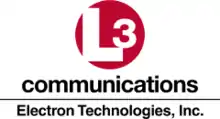Stellant Systems Inc.
Stellant Systems Inc. is a manufacturer of microwave devices for ground-based, airborne and satellite communications and radar. In October 2021, Stellant systems came into being when L3Harris Technologies sold its Electron Devices and Narda West divisions to Arlington Capital Partners, A Washington D.C. based private equity firm. The company was formed from the former Electron Devices Division (EDD) of the Industrial Electronics Group of the Hughes Aircraft Company, and from the Litton Industries, both of which were acquired L-3 Communications Holdings, Inc. prior to its merger with Harris Corporation. They are known for their traveling-wave tubes (TWTs), traveling-wave tube amplifiers (TWTAs), microwave power modules (MPMs) and electronic power conditioners (EPCs) as well as xenon gas ion propulsion systems (XIPS).[1] Since its inception, EDD has produced tens of thousands of TWTs.[2] They are the only U.S. supplier of space-qualified TWTs and TWTAs.[3]
 | |
| Type | Private |
|---|---|
| Industry | Aerospace and defense |
| Founded | 1967 |
| Founder | Howard Hughes Charles Litton Sr. |
| Fate | Arlington Capital Partners acquired L3 Harris Technologies’ Electron Devices + Narda Microwave-West Divisions |
| Successor | Stellant Systems Inc. |
| Headquarters | 3100, Lomita Blvd, , U.S. |
Number of locations | 3 |
| Products | Traveling wave tubes, TWTAs, xenon ion propulsion systems |
| Parent | Arlington Capital Partners |
| Website | stellantsystems |
History
Litton Industries
In 1932, Charlie Litton started his own company in Redwood City, CA. By 1945 his company, known then as Litton Industries, had about 60 employees, about 20 of which were working on vacuum tubes. By 1948, the business had grown to be about half manufacturing equipment and half tubes. After receiving a contract for a magnetron designated the 4J52, as well as follow-on contracts, the company became a major competitor to Raytheon and very profitable. In 1953, Charlie Litton sold Litton Industries to Electro Dynamics Corporation, who renamed themselves to adopt the Litton Industries name. The original Litton Industries, now Litton Industries, Electron Tube Division, grew rapidly. In 1965, Litton Industries bought Sylvania's plant in Williamsport, PA and moved all magnetron production there. In 1975, Litton Industries bought MA-COM Tube Operations, and in 1993 bought Raytheon Microwave Power Tube Operations. During the 1990s, Litton developed tubes and became second source for most of the Hughes EDD's airborne radar tubes. In 2001, the company was purchased by Northrop Grumman, becoming Litton Electron Devices. A short time later in 2002, Northrop sold Litton to L-3 Communications, who renamed it L-3 Electron Devices.[4][5]
Hughes Microwave Tube Division
In the early 1950s, Hughes secured a military contract for the XF-108 Rapier interceptor's AN/ASG-18 fire control system and radar. At the end of the Korean War, the F-108 program was canceled, but Howard Hughes chose to keep the program going on company money. By 1959 Hughes Microwave Tube Division was operating in Culver City, California. Hughes was developing TWTs suitable for airborne radar, and eventually won the contract for the F-14 radar system. By the time the F-14 program went into production, the tube division had outgrown the Culver City facility. Hughes moved the operation to Torrance, California, in 1967, and it became Electron Dynamics Division (EDD) within the Industrial Electronics Group.[4]
General Motors purchased Hughes Aircraft Company in 1985. The Boeing Company purchased GM's satellite operation in 2000, acquiring EDD in the process, and renamed it Boeing Satellite Systems, Electron Dynamic Devices, again maintaining the initials EDD. Boeing sold EDD to L-3 Communications, Inc. in 2005. L3 already owned another company using the initials EDD, thereby prompting a name change to L-3 communications, Electron Technologies, Inc. or ETI for short. Boeing sold the property in Torrance to RREEF America REIT III Corporation (RREEF) in October 2006.[6]
References
- "ELECTRON TECHNOLOGIES, INC. - OVERVIEW". Archived from the original on June 30, 2011. Retrieved July 14, 2011.
- "Traveling Wave Tubes (Military & Telecommunication)". Archived from the original on December 20, 2007. Retrieved July 14, 2011.
- "Jane's Space Systems and Industry". Archived from the original on April 26, 2012. Retrieved July 8, 2011.
- Pond, Norman H. (2008). The Tube Guys. West Plains, Missouri: Russ Cochran. pp. 125, 187, 202 & 322. ISBN 978-0-9816923-0-2. Archived from the original on 2010-06-19.
- "Heritage". Retrieved 2019-12-17.
{{cite web}}: CS1 maint: url-status (link) - "Draft Statement of Basis" (PDF). Retrieved 2015-03-13.